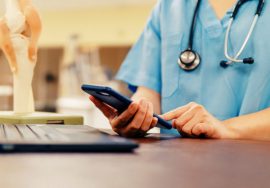
What Pharmaceutical Companies Need to Do To Succeed in the Digital Realm
- Spurred on by the COVID-19 pandemic, digital channels have become critical to pharmaceutical companies for engaging both healthcare practitioners and patients.
- Promotional content delivered digitally by pharmaceutical companies has become overwhelming for HCPs and feels inauthentic.
- Digital content that is both engaging and caters to the individual learning preferences of HCPs, such as webinars, results in higher engagement and ensures key message retention.
- Tailored content is now expected from digital users across platforms due to personalisation becoming more common on mainstream social media; HCPs are no different and, therefore, understanding and catering to their individual preferences is absolutely necessary for driving engagement.
- By virtue of their inherent perceived neutrality, third parties such as physician networks and medical content publishers can help improve trust in and receptiveness to pharma-sponsored content.
The Transition to Digital
The COVID-19 pandemic was a major catalyst to the ongoing digitalisation of business processes, particularly sales and marketing. The need to adapt to the unforeseen disruptions to traditional marketing channels resulted in a rapid increase in the adoption of digital channels (1). Due to a rather belated recognition of the cost-effectiveness and far superior reach of digital channels for marketing, the adoption of digital marketing practices has increased dramatically across multiple industries, including the healthcare and life science sectors. US pharmaceutical companies were projected to have spent $10 billion in 2020 on digital advertising (2). Despite the fading out of pandemic-era restrictions on offline marketing activities, pharmaceutical companies remain committed to the long-term development of digital channels to reach both HCP and patient populations. The recent surge in investment by pharma companies in developing their own physician portals and digital therapeutics offerings is proof of the long term stickiness of digital adoption in pharmaceutical marketing despite some normalization from the unprecedented highs reached during the pandemic.
92% of lifesciences and 96% of technology companies plan to increase their investment in digital healthcare (3).Remote detailing platforms, physician portals and email marketing systems have become integral to pharma companies’ digital HCP engagement strategies. Digital channels in the life science industry are here to stay and the change is being welcomed by HCPs. With the increase in adoption of digital technology in the healthcare sector and the high digital proficiency of the new generation of HCPs, awareness of and interest in digital channels for continuing medical education, clinical reference and overall professional development are increasing among practitioners (4). Yet, even as digital is increasingly being recognized as the future of pharmaceutical-practitioner relationships, significant improvements and changes are still needed in pharmaceutical companies’ digital marketing models and practices to ensure that HCPs are receptive to their digital content.
The Need for Personalisation
The pandemic triggered a huge shift in consumer behaviour, especially in terms of how long customers spent online and on social media, particular (1). Recreational screen time spiked during the pandemic with apps like Facebook and Instagram becoming a large part of the average person’s downtime. Given the ability of these mainstream social media platforms to dynamically track each user’s past behaviour and deliver an ever-more personalised experience for each user, highly personalised newsfeeds, search results, friend recommendations and advertorials are now expected from digital users across all platforms. Just like all digital users, HCPs cannot be clumped together into a ‘One-Size-Fits-All’ demographic and bow expect a high level of personalisation from all digital platforms they interact with, including those that are used solely for professional purposes. Preferences for the type of information received (e.g. disease or therapy information, treatment guidelines or clinical trials data), the format in which the information is organised (e.g. live events, recorded videos, infographics or articles), time of day to receive content and devices used vary based on the individual, but the digital practices currently employed by pharmaceutical companies are yet to reflect this. 62% of HCPs said that a way for pharmaceutical companies to improve the effectiveness of their digital initiatives is to understand the needs of the individual and only share relevant content such as product guidelines and safety profiles (5). The prevailing pharma industry practice of digitally ‘’bombarding’’ HCPs with one-size-fits-all content is not working and this is reflected in low engagement and audience retention across pharma-owned digital touchpoints.
For third-party networks such as Medisetter, personalisation is an essential part of the product and business strategy. Using the ever-growing repository of user engagement data and also factoring in the explicitly-stated professional interests and detailed demographic and professional profile of each member in its network, the Medisetter app uses a proprietary algorithm to create a hyper-personalised experience including a tailored newsfeed and peer follow recommendations akin to popular social media platforms.
By virtue of being a brand-agnostic third-party aggregator of various types of sponsored as well as non-sponsored content, Medisetter can gather engagement data across a more diverse mix of content than an individual pharmaceutical company typically could through its own in-house digital assets. This superior data quality allows for more informed content recommendations to each user and more effective customisation of their experience on the app. Better personalisation, in turn, typically drives higher engagement, further enriches the engagement history of the given user and allows for ever greater personalisation in a positive feedback loop.
Why Webinars Work and What They Signal About HCP Preferences
As a result of the pandemic, conferences were rendered logistically unviable and therefore webinars or virtual events became the alternative method for HCPs to engage with new scientific material and personal development. Despite a degree of ”webinar fatigue” during the pandemic, in a recent survey 68% of HCPS indicate that webinars are their preferred channel for staying professionally updated and relevant (5).
When Medisetter surveyed its network of HCPs, the results supported the findings from the third-party source cited above, with an overwhelming number of practitioners rating webinars as the most important source for expanding their clinical knowledge. 50% of Vietnamese practitioners rated webinars as a more important source of information than offline medical conferences, websites and discussions with peers.

But why are webinars preferred to other digital formats?
Firstly, HCPs want curated content that is matched to their unique needs and interests (6).
Inherently, webinars cater to this need better than other forms of digital content because of the self-selecting attribute of this content format: the main content in a webinar is delivered to those who choose to register and participate. Since HCPs will typically only make the effort to register for and attend a webinar if the topic is of interest to them, the chances that an HCP attending a webinar finds the content to be irrelevant is rather low. Needless to say, the invitation to the webinar could still be delivered in a manner that is not personalised (e.g. inviting an HCP that is not interested in the particular topic of the webinar) but once the participant is already attending the webinar, there is likely to be a high degree of content relevance leading to greater satisfaction (invitations received to attend webinars on irrelevant topics– while common — do not appear to impact the perceived usefulness of webinars as a source for continuing medical education).
Furthermore, because webinars involve a speaker who is typically an HCP, the content is likely to be less promotional and commercial than a newsletter, article or infographic because most well established HCPs would be weary of compromising their professional reputation and integrity by appearing to be a ‘’mouthpiece’’ for a particular pharma company. Furthermore, HCPs attending events – whether offline or virtual – typically expect to earn CME credits and in most countries, medical events need to be scientifically endorsed and educational enough in nature to qualify for such CME credits. Lastly, receiving content from another practitioner is likely to feel more authentic and credible than receiving a newsletter from an email address which often cannot be associated with a particular person.
The popularity of webinars is proof of the fact that for HCPs to truly engage with content, it has to be authentic and credible and matched to their interests.
Using Third-party Networks To Reduce Perceived Bias
The biggest barrier to engagement faced by pharmaceutical-owned digital channels is the perceived bias prevalent in their content. Narrow, product-focused content makes up the majority of content HCPs receive from pharma companies and, as a result, HCPs’ perception of pharmaceutical digital content is that it is commercial and biased.

Third-party networks like Medisetter act as the bridge between HCPs and pharmaceutical companies, thereby reducing perceived agency conflicts. A non-pharma content aggregator or physician network is an agnostic interface which distances the content marketed to HCP from the bias associated with pharma-owned digital channels. This neutrality helps bring credibility to pharma-sponsored content. Furthermore, the feeling of digital bombardment is alleviated by physician networks like Medisetter given the interactive nature of such platforms. Medisetter can be used by HCPs for meeting other professional needs like peer-to-peer exchange and professional networking, in addition to reading content or participating in CME programs. Hence, even when sponsored content is received by HCPs through Medisetter, it feels like it is being delivered more discreetly, rather than being pushed to them.
Lastly, and most importantly, by combining sponsored, unsponsored and neutral content on the platform, Medisetter eliminates the perception of bias within their platform resulting in HCPs being more trusting of the content they engage with.
To summarise, for pharmaceutical companies to succeed in the digital realm they need to learn from and cater to HCPs expressed preferences. In particular, they should:
- Invest more in providing useful clinical information (e.g. disease information, treatment guidelines) rather than overwhelming HCPs with product-focused content.
- Track the expressed content topic and format preferences of their target HCPs and tailor the content mix accordingly to match each individual’s preferences.
- Partner with third-party aggregator content portals or physician networks to amplify the impact of their in-house digital initiatives to engage HCPs.
References
- Shiyas, M. The Evolution of Digital Marketing: Post-COVID Insights. https://www.linkedin.com/pulse/evolution-digital-marketing-post-covid-insights-muhammed-shiyas-0vbhc/.
- How the pharmaceutical market has transformed one year on from Covid-19 lockdowns | IQVIA news and blogs (no date). https://www.iqviamedicalsalescareers.com/article/2021-3/how-the-pharmaceutical-market-has-transformed-one-year-on-from-covid-19-18425953496.
- McMahon, N. (2018) The cutting edge: Shaping the future of digital healthcare. https://www.linkedin.com/pulse/cutting-edge-shaping-future-digital-healthcare-naveet-mcmahon/.
- Lad, P., Muragundi, P. and Ligade, V.S., 2017. Digitalize pharmaceutical marketing: Medical representative perspective. Research Journal of Pharmacy and Technology, 10(7), pp.2179-2182.
- The Digitally-Savvy HCP Learnings to engage HCPs around the world More effectively and efficiently | Reports | What We Think | Indegene (no date). https://www.indegene.com/what-we-think/reports/digitally-savvy-hcp.
- Digital, Q. (2022) Webinar: The Resurgence of eNewsletters. https://www.questline.com/blog/webinar-resurgence-of-enewsletters/.




